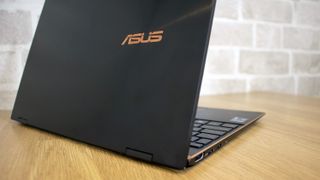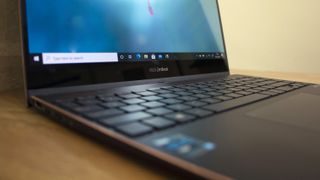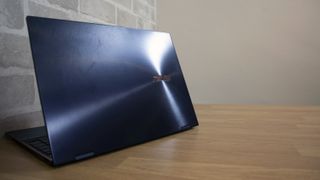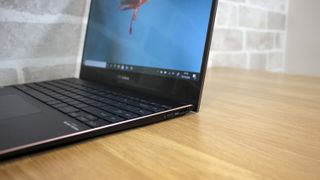IT Pro Verdict
Pros
- +
Fantastic 4K screen
- +
Slick, attractive and lightweight design
- +
Great keyboard and trackpad
- +
Solid battery life
Cons
- -
No faster than older Intel CPUs
- -
No headphone jack
- -
No fingerprint or card reader













The latest iteration of the Asus ZenBook Flip S is the first laptop we’ve seen with one of Intel’s new Tiger Lake processors – but the 11th Gen silicon isn’t the only thing to notice on this hybrid. It’s got a superb 4K screen, a keen sense of design and several future-proofed features.
The ZenBook costs £1,499 exc VAT, which certainly isn’t bad when compared to its rivals – machines like the Dell XPS 13, its hybrid variant and the Apple MacBook Air are all more expensive when specified with equivalent components, while the HP Spectre x360 has an identical price. But does this affordable price equate to good value?
Asus ZenBook Flip S UX371 review: Design
The ZenBook is easily stylish enough to turn heads. Its body deftly combines dark aluminium alloy with copper-coloured accents, and the letters on the keyboard are finished in a matching shade. Build quality is good too: the ZenBook’s screen is one of the sturdiest we’ve used on a small laptop, and there’s barely any movement in the base unless you use serious force. It’s not exactly chunky, either – the Flip weighs 1.2kg and is 14mm thick.
The impressive build quality is bolstered by smooth movement; the 360-degree hinges feel robust and the ZenBook is easy to switch between laptop, tablet and tent positions. The only slight issue here is that the machine can’t be opened using a single fingertip.
The Asus undercuts rivals – it’s slimmer, lighter and just as sturdy as the more expensive machines above. The only way you’ll get something lighter is by opting for a machine like the Asus ExpertBook B9450F, but you lose the 2-in-1 functionality and stunning design.

Asus ZenBook Flip S UX371 review: Keyboard and trackpad
The Asus has a sunken keyboard with a reasonable 1.4mm of travel. The buttons are wide, if a little short, and the copper text is augmented by a white backlight. It’s only got a single-height Return key, but the keyboard does have an extra row of function buttons on its right-hand edge.
The short buttons take a little getting used to, but the keyboard is excellent. It’s quiet, consistent and comfortable, with impressive speed and a great balance between crispness and softness. Apple’s MacBook Air has shallower keys that are similarly satisfying, while Dell’s buttons are shallow but with a firmer feel. These keyboards are all fantastic, however – it’s just about picking your preference.
The trackpad is incredibly wide, and its surface is precise and smooth. Its in-built buttons are fast, and it has an extra trick up its sleeve: tapping the top-right corner of the pad superimposes a virtual numberpad over the top of the glass. It’s a cool feature, and one that will appeal to those bemoaning the lack of a physical equivalent.
Asus ZenBook Flip S UX371 review: Display
The ZenBook is kitted out with a 13.3in 4K OLED touchscreen with a matte finish. When it comes to screen technology, that’s top-notch. The Asus has a fantastic density level of 331ppi, and it means that this panel is incredibly sharp, looking bolder and more luxurious than any IPS display.
The OLED technology delivers perfect contrast – black shades have depth that can only be matched by other OLED panels, and the peak brightness of 502cd/m2 delivers huge punch and impact. The colour temperature of 6,622K is great, and the panel rendered 100% of the sRGB gamut, 95.8% of the Adobe RGB space and 98.4% of the DCI-P3 colour space. Uniformity is superb, and the panel’s brightness only deviated by a maximum of 8%. The only downside is the Delta E of 3.57, which is good rather than great.

The vibrancy, contrast and colour temperature combine with those gamut levels to ensure that this display can be used to work inside the sRGB, Adobe RGB and HDR colour spaces. The Delta E is the only issue, and that’s only going to put off the most demanding creatives – and most of those people will be working on true mobile workstations anyway.
The display compares well to rivals. The XPS 13 has poorer brightness and sRGB coverage, while Dell’s 2-in-1 is brighter but with poorer contrast, and the Apple has a lesser resolution. The HP Spectre uses AMOLED, but it’s not as bright as the Asus’ panel.
The speakers are tremendous – loud and clear, with mid-range clarity, loads of depth and surprising bass. They’re plenty good enough for media and music and easily the match of any rival.
Asus ZenBook Flip S UX371 review: Hardware & Performance
The Core i7-1165G7 is one of Intel’s new Tiger Lake processors. This updated architecture brings plenty to the table – at least on paper – when compared to Ice Lake CPUs. The move to a better 10nm manufacturing process promises faster clock speeds, and elsewhere there’s better integrated graphics cores, support for LPDDR4x memory and PCIe 4.0 and native support for WiFi 6 and Thunderbolt 4.
The i7-1165G7 has four Hyper-Threaded cores, and the new architecture gives Intel more clock speed versatility. This chip can run at anywhere between 1.2GHz and 2.8GHz, and it’s got a solid peak Turbo speed of 4.7GHz. The improved versatility can be seen clearly in the TDP, which can vary from 12W to 28W.

On paper, this chip compares favourably to the Core i7-1065G7, which had more rigid base and boost speeds of 1.3GHz and 4.9GHz and a TDP of 15W. In testing, though, it becomes clear that the ZenBook doesn’t make use of the CPU’s abilities. In our benchmarks it scored 83, including 66 in the multi-tasking test. That’s not bad, but those figures sit behind both Dell XPS 13 machines, which were tested with the Core i7-1065G7.
Delving into Geekbench 5 gives more indication about what’s going on. Initially the ZenBook scored 1,545 and 5,006 in the single- and multi-core tests, but over multiple runs the latter score dropped by around 1,000 points, while the former result barely changed. The CPU is clearly throttled when it comes to multi-core performance. It’s not a terrible situation – the older Core i7 chip is still a little slower in both tests – but it does show that the Tiger Lake CPU is not being used to its full potential.
Nevertheless, the i7-1165G7 handled web-browsing, Office applications and mainstream photo-editing without any problems. The CPU’s great single-threaded performance has an impact, and the superb SSD read and write speeds of 3,200MB/sec and 2,836MB/sec keep the machine responsive. You’re only going to run into trouble if you try to run high-level, multi-threaded applications. When that happens, the base of the machine gets uncomfortably hot, too – so you’ll at least have some warning. Happily though, the Asus is always quiet.
Intel’s new integrated graphics core scored 9,523 points in 3D Mark Sky Diver. That’s a solid gain over older iGPUs, which hovered at around 7,000 points. It’ll help a little in photo-editing and when playing casual games, but it’s not a transformative result.
The ZenBook did get a decent result in our video playback test, lasting for 11hrs 3mins. That’s better than the Dell XPS, its hybrid variant, the HP Spectre and the Apple MacBook Air. Better longevity can be found elsewhere, though – the Asus ExpertBook B9450F doubled the ZenBook’s lifespan. Still, there’s enough ability here to handle a working day away from the mains alongside a decent commute.
Asus ZenBook Flip S UX371 review: Ports and Features

On the left-hand side are two USB-C ports that support Thunderbolt 4, which means a huge maximum bandwidth of 40Gb/sec. There are no Thunderbolt 4 devices that can make use of that speed right now, but it’s a welcome, future-proofed addition. On the right-hand side is a full-size USB 3.2 Gen 1 port that peaks at a more pedestrian 5Gb/sec.
Elsewhere, the Asus has an HDMI port, dual-band WiFi 6 and Bluetooth 5.0, and its internal specification is rounded out by 16GB of memory and a 1TB SSD. The 720p webcam supports Windows Hello, and on the inside the ZenBook has TPM 2.0.
The ZenBook doesn’t have a headphone jack, though – an odd thing to ditch given their tiny size. At least a USB-C-to-audio adapter is included in the box alongside a USB-to-Ethernet adapter and a stylus. This machine has no card or fingerprint readers, and the webcam doesn’t have a physical privacy shutter – although it does include a shortcut on the keyboard to disable the camera.
The Asus has more features than Apple’s machines, but the HP Spectre and Dell’s systems are arguably more useful thanks to their fingerprint sensors and microSD slots.
Asus ZenBook Flip S UX371 review: Verdict
The ZenBook’s 4K OLED screen has great quality and it's crisper than the Walkers factory, the design is stylish and sturdy, and it serves up good battery life and reasonable performance. The keyboard and trackpad impress, too. It’s cheaper than most rivals with equivalent hardware: the Dell XPS 13 costs £1,624 exc VAT and £1,708 exc VAT in its laptop and hybrid guises and the MacBook arrives at £1,540 exc VAT. Only the Asus ExpertBook costs less, but it’s hindered by its poorer screen.
That said, the ZenBook is not without fault. The CPU doesn’t deliver any significant advantage over last-gen chips, and it’s missing some features that would have made working life easier. If you need those, Dell and HP’s machines are better.
For many people, though, the Asus’ issues will be acceptable compromises when so much else is impressive. This is a good-looking, effective, and versatile hybrid.
BY: Mike Jennings
Asus ZenBook Flip S UX371 specifications
| Processor | 1.2-2.8GHz Intel Core i7-1165G7 |
| RAM | 16GB LPDDR4X |
| Graphics | Intel Iris X Graphics |
| Storage | 1TB WD SN730 SSD |
| Display | 13.3in 3,840 x 2,160 OLED |
| Operating System | Windows 10 Pro 64-bit |
| Connectivity | Dual-band 802.11ax WiFi, Bluetooth 5.0, Gigabit Ethernet |
| Ports | 2 x USB 3.2 Gen 2 Type-C/Thunderbolt 4, 1 x USB 3.1 Gen 2 Type-A, 1 x HDMI |
| Dimensions | 305 x 211 x 14mm (WxDxH) |
| Weight | 1.2kg |
| Warranty | 1yr RTB |
Mike Jennings has worked as a technology journalist for more than a decade and has been fascinated by computers since childhood, when he spent far too long building terrible websites. He loves desktop PCs, components, laptops and anything to do with the latest hardware.
Mike worked as a staff writer at PC Pro magazine in London for seven years, and during that time wrote for a variety of other tech titles, including Custom PC, Micro Mart and Computer Shopper. Since 2013, he’s been a freelance tech writer, and writes regularly for titles like Wired, TechRadar, Stuff, TechSpot, IT Pro, TrustedReviews and TechAdvisor. He still loves tech and covers everything from the latest business hardware and software to high-end gaming gear, and you’ll find him on plenty of sites writing reviews, features and guides on a vast range of topics.
You can email Mike at mike@mike-jennings.net, or find him on Twitter at @mikejjennings
